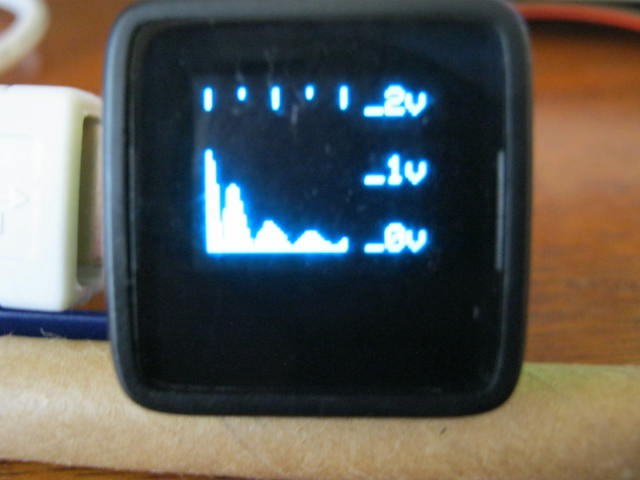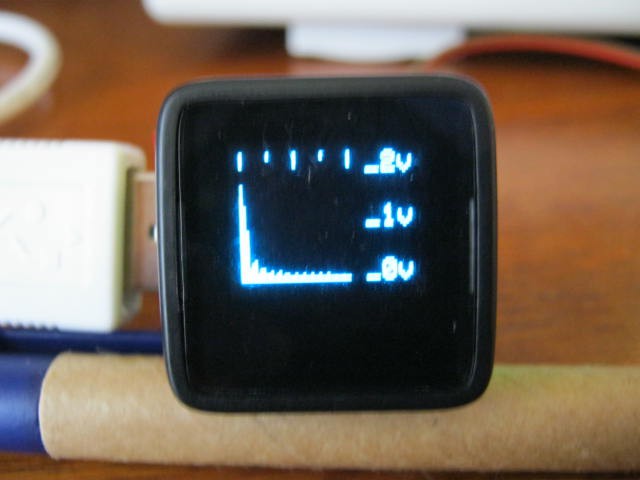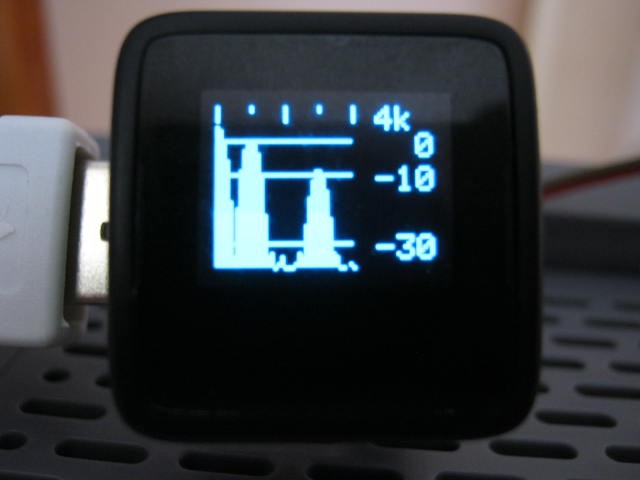Nokia LCD Display
I have a few of these lying around and I wrote some code using a DigiSpark a while back. The code is based on work by Julian Ilett (https://www.youtube.com/playlist?list=PLjzGSu1yGFjXWp5F4BPJg4ZJFbJcWeRzk).
First problem is that the display needs 5 output pins and the DigiSparks only has five IO pins so that is not going to work (i.e. no pin left for the signal input).
I could use an Arduino UNO with the Nokia LCD Display.
MicroView
I have a MicroView so I may as well use that.
So here it is listening to a 3v 1kHz square wave:
The top gradations are 0 kHz, 1.25 kHz, 2.5 kHz, 3.75 kHz and 5 kHz.
You can see the DC, 1 kHz and the harmonics but they off a little bit.
Next there is quite a bit of jitter at low frequencies, here is another shot:
Here is the same square wave but with a 20kHz:
Need to check the actual average sample time for each pass.
Need understand the nature of the jitter.
Is it an interrupt or is it due to the algorithm?
Need some free IO pins for an option menu (after I solve the other problems).
Here is the current code:
#include <MicroView.h>
// Audio Spectrum Analyser
#define SampleInput A0 // Name the sample input pin
#define BandWidth 500 // BandWidth
#define MaxFreq 4000 // Max analysis frequency
#define Trigger 10 // Trigger to synchronise the sampler 2vpp at 1kHz = 32
// Define various ADC prescaler
const unsigned char PS_16=(1<<ADPS2);
const unsigned char PS_32=(1<<ADPS2)|(1<<ADPS0);
const unsigned char PS_64=(1<<ADPS2)|(1<<ADPS1);
const unsigned char PS_128=(1<<ADPS2)|(1<<ADPS1)|(1<<ADPS0);
// Setup the serial port and pin 2
void setup() {
// Setup the ADC
pinMode(SampleInput,INPUT);
ADCSRA&=~PS_128; // Remove bits set by Arduino library
// Set prescaler
// ADCSRA|=PS_64; // 64 prescaler (250 kHz assuming a 16MHz clock)
// ADCSRA|=PS_32; // 32 prescaler (500 kHz assuming a 16MHz clock)
ADCSRA|=PS_16; // 16 prescaler (1 MHz assuming a 16MHz clock)
uView.begin(); // Start MicroView
uView.clear(PAGE); // Clear page
uView.println("Spectrum Analyser"); // Project
uView.println("0-20 kHz"); // Range
uView.println();
uView.println("agp.cooper@gmail.com"); // Author
uView.display(); // Display
uView.clear(PAGE); // Clear page
delay(2000); // Wait
}
void loop() {
static byte *samples; // Sample array pointer
static byte *window; // Window array pointer
static int N=0; // Number of samples for BandWidth
static long sampleFreq; // Sample frequency
long freq; // Frequency of interest
float s; // Goertzel variables
float s_prev;
float s_prev2;
float coeff;
float magn;
int i;
if (N==0) {
// Check sample frequency and set number of samples
samples=(byte *)malloc(100);
unsigned long ts=micros();
for (i=0;i<100;i++) samples[i]=(byte)(analogRead(SampleInput)>>2);
unsigned long tf=micros();
free(samples);
sampleFreq=100000000/(tf-ts);
N=2*sampleFreq/BandWidth+1;
uView.setCursor(0,0); // Set cursor to beginning
uView.print("SI: A"); // Sample input pin
uView.println(SampleInput-14);
uView.print("SF: "); // Sample frequency
uView.println(sampleFreq);
uView.print("MF: "); // Max frequency
uView.println(MaxFreq);
uView.print("BW: "); // andWidth
uView.println(MaxFreq);
uView.print("SN: "); // Number of samples
uView.println(N);
uView.display(); // Display
uView.clear(PAGE); // Clear page
delay(2000);
// Create arrays
samples=(byte *)malloc(N);
window=(byte *)malloc(N);
// Modified Hamming Window
for (i=0;i<N;i++) window[i]=(byte)((0.54-0.46*cos(2*M_PI*i/(N-1)))*255);
// Generate test samples
for (i=0;i<N;i++) {
samples[i]=(byte)(30*(sin(2*M_PI*i*5000/sampleFreq)+sin(2*M_PI*i*2500/sampleFreq)+sin(2*M_PI*i*7500/sampleFreq)+sin(2*M_PI*i*10000/sampleFreq))+127);
}
}
if (true) {
// Sychronise the start of sampling with data slicer
int a0,a1;
a0=1023;
for (i=0;i<N;i+=2) {
a1=analogRead(SampleInput);
a0=(a0*13+a1*3)/16;
if (a1>a0+3) break;
}
for (i=0;i<N;i++) samples[i]=(byte)(analogRead(SampleInput)>>2);
}
// Scan frequencies
for (freq=0;freq<=MaxFreq;freq+=(MaxFreq/40)) {
// Goertzel (https://en.wikipedia.org/wiki/Goertzel_algorithm)
coeff=2*cos(2*M_PI*freq/sampleFreq);
s_prev=0;
s_prev2=0;
for (i=0;i<N;i++) {
s=0.0000768935*window[i]*samples[i]+s_prev*coeff-s_prev2;
s_prev2=s_prev;
s_prev=s;
}
// Get magnitude
magn=2*sqrt(s_prev2*s_prev2+s_prev*s_prev-coeff*s_prev*s_prev2)/N;
// Display on MicroView
uView.line(freq*40/MaxFreq,47,freq*40/MaxFreq,10-(int)(20*log10(magn+0.0001)));
}
// Frequency graduations
uView.setCursor(47,0);
uView.print(MaxFreq/1000);
uView.print("k");
uView.line(0,0,0,5);
uView.line(10,0,10,2);
uView.line(20,0,20,5);
uView.line(30,0,30,2);
uView.line(40,0,40,5);
// Voltage graduations
uView.line(0,40,40,40);
uView.setCursor(47,38);
uView.print("-30");
uView.line(0,20,40,20);
uView.setCursor(47,18);
uView.print("-10");
uView.line(0,10,40,10);
uView.setCursor(47,8);
uView.print(" 0");
//Display
uView.display();
uView.clear(PAGE);
}Fixes
Measured the sample frequency on the fly.
Dynamically determined the sample number and allocated the memory for the arrays.
For the phase error issue I added a data slicer (with a time out) to try an synchronise the input signal (if possible).
Convert amplitude to a log scale.
So here it is testing the 1 kHz 3v square wave (using a 500 Hz bandwidth):
Quite stable - very little jitter.
The magnitude is RMS voltage.
The 4k at the top right-hand corner is the maximum frequency of the analysis.
The nominal band width is 500 Hz (actually 250 Hz before the Hamming Window).
You can see the spectrum noise below -30dB.
Project Complete
Until I find something to do with this project I am going to call it complete!
AlanX
 agp.cooper
agp.cooper



Discussions
Become a Hackaday.io Member
Create an account to leave a comment. Already have an account? Log In.
Hi Trevor,
Great, enjoy.
Regards AlanX
Are you sure? yes | no
Thanks for doing all this hard work. I need a GHz analyzer display, but will implement your code then use its graphics as a framework for expansion. Thanks again! :)
Are you sure? yes | no